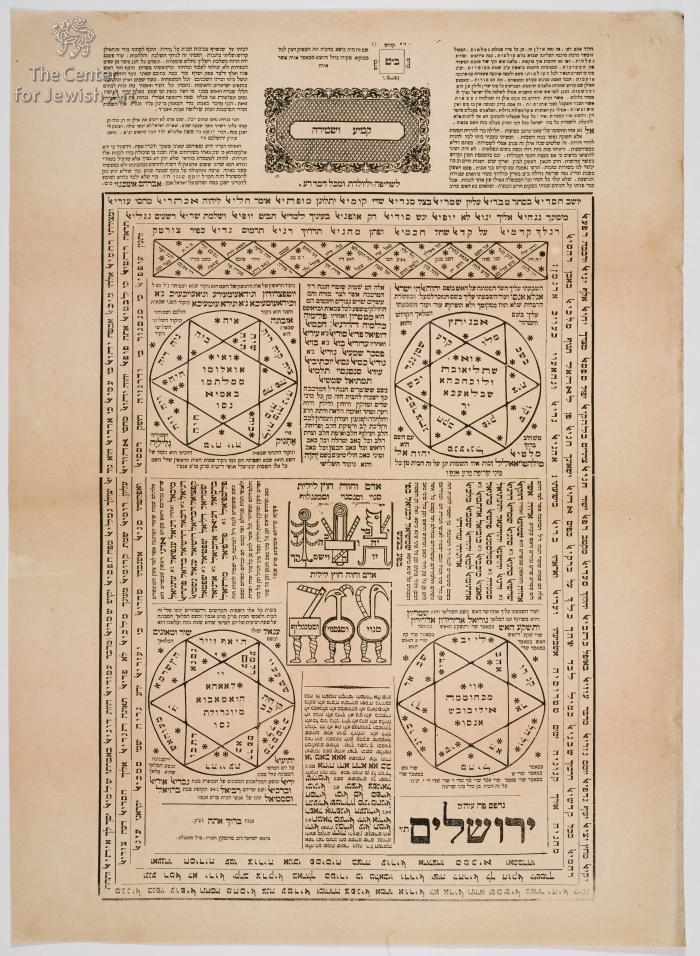Obj. ID: 54449 Kame'a ve-Shmirah, Jerusalem, 1874

sub-set tree:
The following description was prepared by William Gross:
From earliest times, man has tried to protect himself from misfortune by the use of objects which he considered holy or otherwise (e.g., magically) potent. Amulets and talismans are Items generally worn around the neck or wrist, carried in a pocket or purse or hung on a wall. They are meant to protect or aid those who carried or wore them. The Hebrew word for amulet, kame‘a, has the root meaning "to bind". Jewish amulets are usually comprised of texts (either letters or graphic symbols) that are inscribed on some sort of material; some may also contain plant matter or precious stones. The texts of amulets usually include holy names that are believed to have the ability to affect reality, along with incantations summoning angels or other magical powers. For the most part, an amulet has a specific purpose: to ease childbirth, facilitate recovery from illness, improve one’s livelihood, and so on, but in the modern world many are also made for general protection.
Amulet and Protection from Fires and for a New Mother and from all Evil Matters - Kabbalistic Illustrations - Printed Leaf Printed amulet for protection from fire, for a new mother and from all evil matters, angels' names, incantations, oaths, drawings of angels and kabbalistic drawings, by R' Yosef Eligula. Yisrael Dov Frumkin Press, date chronogram:'ברוך את"ה לפ"ק.' Unknown. From the printer's words: 'You have seen adornment, how beautiful is this tree, its fruits are all wonderful regulars, functioning and made in the image of the upper Merkavah created by the Creator of worlds, some combinations and hidden secrets, see how the walls are surrounded ... I decree ex-communications... no person may print this tree, whole or in part, without my permission for seven years, the remnant of Israel will not commit injustice, he who heeds me shall be safe. Words of Yosef son of Moshe Eligula, native of Kota, resident of Jerusalem.
This specific form of amulet was first published by Israel Dov Frumkin soon after the establishment of his printing press in Jerusalem in 1874. It was published in tthree different versions then as well as on different colored paper. Subsequently, it appeared in many different printings, some by Frunkin himself but afterwards by many different presses in other variations even until today. Many of these publications are represented in the Gross Family collection. Frumkin was an important printer of books and single sheets for almost 30 years. Such a single sheet was printed to be hung on the wall of a home and represents the kind of printed single pages that made their frequent appearance in the marketplace during the last half of the 19th century. This is the type of decorative page that provided the average Jewish person with the ability to have "art" on the walls of his home. Franklin was the son-in-law of the first printer in Jerusalem, Yisrael Bak, and worked in Bak's printing establishment from 1870 until he acquired his own press four years later. He was also the printer and editor of the Hebrew newspaper "Havatzelet".
This amulet was intended, as described in the large letters at the top, as a talisman and Shmirah against fire, as a protection for a pregnant woman, and as a general shield against all bad things. It contains many Kabbalistic formulae and "names" as well as a number of visual elements. The amount of text is much greater than what is normally seen and deals with names of angels and other Kabbalistic lore for protection of the house and its inhabitants.


